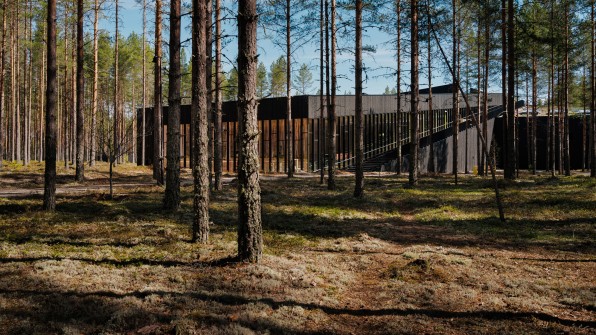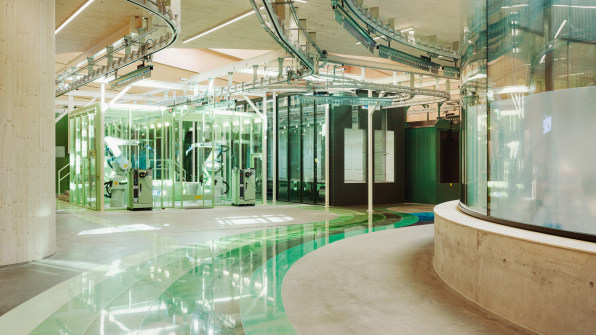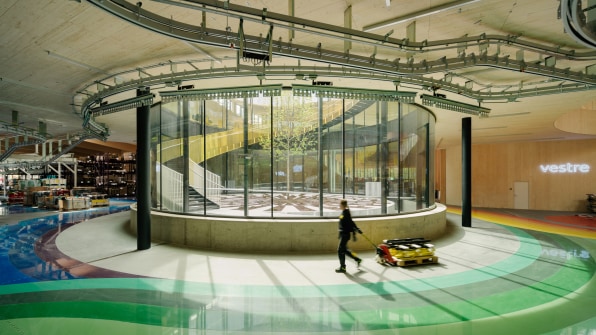Although the new Vestre home furnishings manufacturing unit exterior Oslo promises to be the world’s most sustainable factory, a additional defendable title is that it is the very first to be affected by Saturday morning cartoons.

The factory’s designer, architect Bjarke Ingels and his firm Bjarke Ingels Team, tapped into some childhood recollections of Danish Television when devising the project’s design thought. As an interlude between cartoons, tv stations would sometimes engage in transient films from within factories, showing how day to day goods like footwear and pencils had been manufactured.
“It was mesmerizing to check out these processes,” Ingels states by mobile phone from Copenhagen. He made the decision to construct that exact feeling of wonder right into the manufacturing unit alone.

Vestre specializes in outside home furniture for community areas, like benches, planters, and garbage cans, and its early steerage to Ingels bundled a purpose of transparency in the way it would make its products and solutions. The new manufacturing facility, formed like a in addition indicator, is the place the firm procedures most of its wood, from sawing to painting to assembly. Outside the house sits a broad pine forest that the organization has turned into a route-spliced community park.
Between the company’s principal raw content exterior and the processed wood furnishings inside are partitions of very clear glass, a literal nod to transparency. Like those people Saturday early morning television courses, the glass gives the curious community a way to peek behind the scenes. “You can push your nose flat towards the home windows and admire the marvel of 21st-century producing,” says Ingels, whose organization is regarded for style-blurring properties like a electric power plant with a ski slope on top rated and dome buildings 3D printed from moon dust.

A see-by means of factory—let by yourself one particular set amid 74 acres of publicly obtainable forest—is a decidedly new take on the gruff and gritty factory of the earlier.
“Normally, factories are these hostile, hermetic, no-trespassing, preserve-out varieties of environments,” Ingels claims. And with superior rationale: Firms have a all-natural concern for industrial espionage, as effectively as the workaday realities of needing to continue to keep up output without the need of a bunch of onlookers clogging the gears.
Vestre’s intention of pulling back again the curtain could only go so much, and whilst most parts of the factory can be viewed from the outdoors, the robotic arms and spinning noticed blades in the work places are just for workforce. “Of training course, it is continue to a factory,” Ingels suggests. “It’s a hardworking building.”

Inside, human home furnishings makers and automatic industrial devices intermix in the 4 wings of the setting up, each individual focused to a certain process: milling, painting, assembly, and logistics. The manufacturing unit employs a shade-coded paint program on the flooring to map out the purposeful flows of each individual quadrant and simplicity movement of supplies between wings. The pathways, like directional aides in massive hospitals, switch the floor into what Ingels phone calls a “rainbow of utility.” The designers even put the shade system to do the job on the large-scale machines and robots, which needed some unique orders from industrial brands.
“It took some convincing,” Ingels says. “The initial response from the German maker was unmöglich, which suggests extremely hard.” The designers finally obtained their way, and Vestre’s manufacturing unit now consists of a lime inexperienced space for painting and a brilliant red saw for reducing large boards. The scene within is not not like what a manufacturing facility may have appeared like in one particular of those previous technicolor Saturday morning cartoons.

Although transparency is the overarching topic, the title the corporation has offered its manufacturing facility, that of “the world’s most environmentally pleasant furnishings factory,” has some merit, too. The setting up was developed to have reduced carbon emissions, significant on-web page renewable vitality creation, and a little embodied footprint of greenhouse fuel emissions to create its building products.
The setting up was built primarily of wooden, with columns, beams, and walls designed of mass timber, insulation built of small-carbon wooden chips, and a facade of insect-resistant charred wooden. The concrete foundation was minimize down to the bare minimum sizing possible to however maintain up the creating, and the designers negotiated with the area fireplace division to take out as handful of trees as doable between the building’s edge and the forest outside of.
“Every selection in the setting up has seriously been produced with a apparent target on what is the smartest, easiest way to decrease the carbon footprint,” Ingels suggests.

Lining quite a few of its outside walls, as properly as the spherical central courtyard at the crosshatch of the moreover sign, are triple-paned windows, which bring all-natural light-weight into nearly every single section of the factory when keeping the temperature interesting in summer and heat in winter.
Substantial stairways line these windows both equally inside and outside the house, producing spaces for employees to transfer across floors and for readers to peer in. At the leading of the stairs is a rooftop deck searching out on the photo voltaic-paneled eco-friendly roofs of the building’s 4 wings and the forest that spreads out past.

The building’s design offers the manufacturing facility a type of two-way transparency. Workers inside of can seem out and see trees although readers can climb the building’s sloping stairs to see the furnishings currently being built. As Ingels puts it: “Everything can perform totally seamlessly, but anything can also be viewed and admired.”